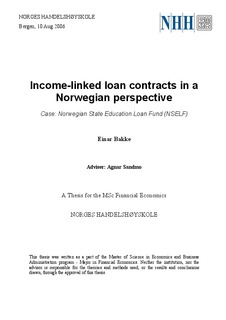Income-linked loan contracts in a Norwegian perspective : case : Norwegian State Education Loan Fund (NSELF)
Master thesis
Permanent lenke
http://hdl.handle.net/11250/167623Utgivelsesdato
2006Metadata
Vis full innførselSamlinger
- Master Thesis [4372]
Sammendrag
This thesis approaches the Norwegian State Education Loan Funds repayment scheme for
student loans. I light of a more digitized Norway it is reasonable to assess more sophisticated
approaches to student loan repayment.
Income-linked loan schemes basically let graduates repay their student loans as fraction of
their income rather then as function of their principal debt. Meaning you that you repay your
loan as a percentage of your income, and thus let your payments follow your income growth.
This has rather attractive feature of giving low-income earners better liquidity in the first
phase of their career. Hence reducing the risk of large student loans for the borrower and
reducing the chance of default for the lender.
The focus of this thesis will be on the repayment scheme. All other aspects of student loans
will only be presented if appropriate.
I will begin this thesis with an introduction of income-linked loans as well as a presentation
of the current history of such repayment schemes in other countries. Thereafter I will
introduction the current theory and discuss a possible Norwegian application of such a
scheme. I will further analyze how such a repayment scheme would have turned out if it had
been employ by the Norwegian State Education Loan Fund in the seventies. Finally I will
suggest a pragmatic solution to individualizing such fractions of income in a way that
follows an individual’s income growth.
